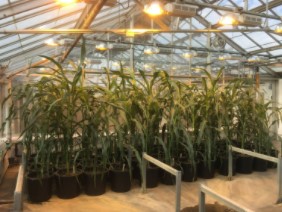The chloroplast is the defining structure of photosynthetic cells. It serves as the site of photosynthesis and is tightly integrated within the metabolic and signaling networks of the plant. The chloroplast is a primary site of environmental stress perception and an important component of stress adaptation and tolerance.
 \
\
Surprisingly, not much is known about how this stress adaptation process works. Starting January 15th, a group of MSU plant biochemists will work on a project funded by the USDA Agriculture and Food Research Initiative Competitive Grants Program to understand how tiny oil droplets in chloroplasts called plastoglobules work to protect the plant during periods of water deprivation and heat stresses.
“The objective of this research project is to understand how the Zea mays (maize) plastoglobule is used to facilitate thylakoid membrane remodeling by developing a comprehensive picture of molecular changes in plastoglobule and thylakoid under water-deprivation and heat stresses,” said principal investigator Peter Lundquist, assistant professor of Biochemistry and Molecular Biology (BMB) in the College of Natural Science. “This research will identify metabolic/protein responses under water-deprivation and heat stresses, presenting novel targets for improved corn varieties, and develop a solid foundation for future studies of plastoglobules in crops.”
The grant is for 2 years and amounts to $425K. Lundquist, who is also associated with MSU’s Plant Resilience Institute, will be collaborating with BMB / MSU-DOE Plant Research Laboratory professors Tom Sharkey and Christoph Benning on specific experiments.

The team will grow maize in a greenhouse and growth chambers. Plastoglobules will be extracted and studied with proteomics and metabolomics. The group will look at protein and lipid compositions and determine what changes occur in healthy and stressed plants and how these changes optimize photosynthesis and defense compounds.
“This research is significant because we are the first to study this in agriculture plants,” said Lundquist. “This project is directly transferable to other crops and will help us determine how farmers can improve productivity in future crop varieties.”
Source : msu.edu